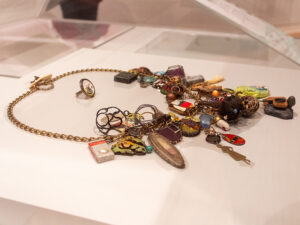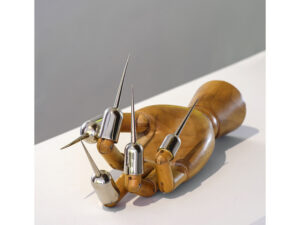
For someone who is so well known (professor at Munich’s Academy of Fine Arts, perhaps the most prestigious jewelry course in the world; widely cited by other jewelers and writers as a key figure in contemporary jewelry; frequent international traveler, instructor, and lecturer, etc.), it is curiously hard to get a fix on Künzli’s body of work. He turns up in lots of books, but it is always a partial representation and usually tied to the period of the late 1970s and early 1980s when, if you’re writing a history, the conceptual trend in contemporary jewelry really takes off. So, my interest in this exhibition is partly about my desire to see a lot of Künzli’s work and get an impression of his practice over four decades, and partly because I am deeply interested to see how his jewelry is tied to this moment. Now that the desire to see contemporary jewelry as a form of art (all about the maker and the object) is being seriously challenged by theoretical frameworks that put the emphasis on the wearer/user (the kind of arguments found in critical design, for example), what does Künzli’s jewelry have to tell us? To state it baldly, I want to know if this exhibition will give us a Künzli for our time or a Künzli oriented to the heyday of conceptual and expressionist art jewelry.

Outside the cases, framed photographs of the Beauty Gallery series (1984) hang along one wall, and The New Flag (1992), a fabric banner with the “mutant Mickey Mouse” logo hangs on the opposite wall. Repeated on the end wall, in large black letters on white, is the phrase “Otto Künzli. Die Austellung.” Once I added together the lack of wall text and caption labels (apart from what is on the handout) and the framed exhibition posters (I assume) available for sale near the door, I found myself thinking that the overall impression is curiously more like a luxury goods concept store than a museum gallery. (I’ll return to this observation later.)

Here’s my first gripe about the labels and wall texts in this exhibition. One group of vitrines is labeled 70, 59, 21, and 3. Why, then, does the handout organize the captions in numerical sequence from 1 to 80? You have to actively search the list to find 3, then 21, then on the other side of the handout, 59 and 70. Why not use a method of organization that would place this information next to each other, and make it easy for the viewer to use? Sure, I can appreciate that as someone writing a review, my desire for names and dates and materials might be greater than many other viewers, but I can’t imagine I am the only person who would be interested to know when something was made, what it is made of, or how Künzli decided to name it.
And here’s my second gripe, which I think is the more important. At no point are we told anything about what this exhibition is intended to do, or what the curator(s) find most interesting about Künzli’s work, and thus what they want this exhibition to emphasize or explore. We’re not even told if there is a curator. (A cryptic statement in the handout says the exhibition “is being realized in close cooperation with the artist.” Later, I hear from a colleague that in Otto Künzli. The Book, the artist is mentioned as the author of the exhibition’s concept, and thus presumably the curator.) There is no wall text in the gallery. This statement from the exhibition handout is the closest thing I could find to some kind of guide to what the show is up to:
Otto Künzli’s works are based on complex reflection, (and) conceptual and visual imagination. The result: objects with a clear, minimalist appearance, captivatingly crafted to perfection, and highly visible— jewelry that adorns and at the same time possesses an autonomous aesthetic status of its own.
What’s missing here is Otto Künzli. The Labels & Wall Text.
(I’m conscious of the fact that this exhibition is framed by the presence of Otto Künzli. The Book, the hefty black volume published by Arnoldsche and launched at the same time. And yet, while these two things are both intended to present Künzli’s jewelry, they aren’t related in any immediate way. The book, in other words, is not a catalogue for the exhibition or a form of wall text and labels, and looking around, it isn’t used in that fashion by any of the audience. There isn’t even a copy you can flick through in the gallery space. As a result, the book has no impact on the exhibition experience, apart from the fact that I imagine many visitors purchasing the book in anticipation of encountering Künzli’s jewelry in this different format.)
At this point, I want to split this review into two, one part focusing on the work itself, and the other on the exhibition, as this is what I found myself doing as I moved through the space. I want to do it, also, because I don’t feel the same about both things. And what I learned from the jewelry itself has implications for what I think about the exhibition. As a result, it makes sense to take them one at a time.

Before I saw the exhibition, a colleague told me that he thought Künzli was actually a 2D artist working in 3D. I think there is something really interesting in that observation. It captures the way Künzli is able to work the territory of the symbol as an icon, effectively a kind of graphic symbol realized in three dimensions. This is why the exhibition poster is so excellent. The red mutant Mickey Mouse glares at us like a malevolent vision of the future, a sign of protest or danger or rebellion, with its roots in graphic agitation. (You can imagine it as a stencil left on the streets at night with an unsettling ambiguity of meaning.) This is an effect intensified by the display of the exhibition, which flattens everything behind acrylic so we look down on the work, in plan, as though it has already been transformed into an image.


And now to the exhibition, which in direct contrast to what I think of the work, is quite disappointing. As a viewer with a couple of purposes—to educate myself and to review the exhibition for AJF—I find the lack of text, and through this, the lack of curatorial guidance to significantly undermine everything that seems most important about the work. The problem here is that this exhibition puts all the weight onto what the handout calls the “autonomous aesthetic status” of Künzli’s jewelry, and it underplays these objects as an investigation of value or of jewelry’s place in a wider system of signs. Sure, some of this is because the objects are sealed off by the vitrine, but it’s also because they are sealed off by Künzli’s own arrangement of his body of work according to formal and conceptual typologies that remain opaque to viewers, or at least to this viewer. What makes these objects and practices live in the culture is denied here. In this context, gold becomes a material he uses sometimes, in various ways and combinations, rather than a sign of jewelry’s historical origins or as a way to push the critique of preciousness or as the key to Künzli’s investigation of systems of value precisely because it is a material with economic and political implications in the world beyond the gallery space.

Ultimately, I’m disappointed that this exhibition doesn’t have the same ambition and rigor as the work that is its subject. And that, I think, is a real missed opportunity, especially in a moment when some really interesting discussions are taking place about what contemporary jewelry is going to become, and particularly, what options are available to move beyond putting all the emphasis on contemporary jewelry as autonomous objects of artistic expression. Künzli: the curator. serves up an installation rather than a critical and expansive retrospective exhibition that would engage with his production over the past four decades and be informed by the particular opportunities and challenges of curating contemporary craft or design rather than contemporary art.

After seeing this show, I’d say the answer to my question about Künzli and his time is that his work is both “contemporary” and “jewelry.” As well as being a most perfect model of conceptual jewelry and thus a great definition of what makes contemporary jewelry a unique kind of visual art practice, the exhibition makes me realize how engaged Künzli’s work is, and how it can be an inspiring model for questions around the jewelry side of the equation. But, this is wrong— the work reveals this to me, but the exhibition does not. And so, while Künzli’s practice answers my question, this exhibition, this event, emphasizes all the wrong things. It places all the emphasis on Künzli as an artist and not on the issues of engagement that would make him the jeweler for our times that he should be




